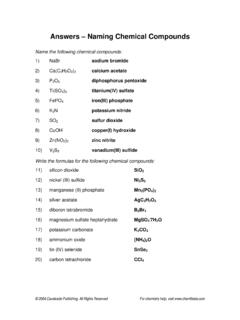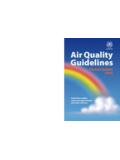Transcription of Air Pollution Control Technology Fact Sheet
1 EPA-452/F-03-034 Air Pollution Control Technology Fact Sheet EPA-CICA Fact Sheet Flue Gas Desulfurization1 Name of Technology : Flue Gas Desulfurization (FGD) - Wet, Spray Dry, and Dry ScrubbersType of Technology : Control Device - absorption and reaction using an alkaline reagent to produce a Pollutants: sulfur dioxide (SO2)Achievable Emission Limits/Reductions: Scrubbers are capable of reduction efficiencies in the range of50% to 98%. The highest removal efficiencies are achieved by wet scrubbers, greater than 90% and thelowest by dry scrubbers, typically less than 80%.
2 Newer dry scrubber designs are capable of higher controlefficiencies, on the order of 90%. Applicable Source Type: PointTypical Industrial Applications: Stationary coal- and oil-fired combustion units such as utility and industrialboilers, as well as other industrial combustion units such as municipal and medical waste incinerators,cement and lime kilns, metal smelters, petroleum refineries, glass furnaces, and H2SO4 manufacturingfacilities. Approximately 85% of the FGD systems installed in the US are wet systems, 12% are spray dryand 3% are dry Stream Characteristics: Unit Size: SO2 scrubbers have been applied combustion units firing coal and oilranging in size from 5 MW to over 1,500 MW (50 MMBtu/hr to 15,000 MMBut/hr).
3 Dry and sprayscrubbers are generally applied to units less than 3,000 MMBtu/hr (300 MW) (EPA, 2000). : For wet scrubbers, typical inlet gas temperatures are 150 C to 370 C (300 F to700 F) (FETC, 1996). For spray dry systems, the temperature of the flue gas exiting the absorbermust be 10 C to 15 C (20 F to 30 F) above the adiabatic saturation temperature. Optimaltemperatures for SO2 removal for dry sorbent injection systems range from 150 C to 180 C (300 Fto 350 F). Optimal temperatures for SO2 removal when applying dry sorbent injection systemsvary between 150 C to 1000 C (300 F to 1830 F) depending on the sorbent properties (Joseph,1998)c.
4 Pollutant Loading: SO2 scrubbers are limited to dilute SO2 waste gas streams of approximately2000 ppm.(Cooper, 2002). d. Other Considerations: The amount of chlorine in the flue gas affects the amount of waterevaporated by the system due to the formation of salts. Chlorine content improves the SO2removal but also results in salt deposition on the absorber and downstream equipment (Schnelle,2002). An additional or upgraded induced draft (ID) fan may be required to compensate for flue gaspressure drop across the absorber.
5 EPA-CICA Fact Sheet Flue Gas Desulfurization2 Many wet systems reheat the flue gas downstream of the absorber to prevent corrosion causedby condensation inside the ducts and stack and reduce plume Stream Pretreatment Requirements: In spray dry and dry injection systems, the flue gas mustbe cooled to a temperature range of 10 C to 15 C (20 F to 30 F) above adiabatic saturation. Thistemperature range avoids wet solids deposition on downstream equipment and plugging of the baghouse. A heat recovery boiler, an evaporative cooler or a heat exchanger is typically used to cool the Information: Capital costs for SO2 scrubbers have decreased by over 30% since the beginning of the 1990's.
6 Currentcosts for SO2 scrubbers applied to electric utilities are reported to be approximately $100/kW (Smith, 2001).Retrofit of scrubbers on existing units can increase the capital cost up to 30%. Retrofit costs vary significantlybetween sites and depend on space limitations, major modifications to existing equipment ( , ductworkand stack) and the operating condition of the units ( , temperature, flowrate).O&M costs increase with increasing sulfur content since more reagent is required to treat the same volumeof gas.
7 Typical reagents such as lime and limestone are inexpensive; however, the use of proprietaryreagents or reagent enhancers or additives that can significantly increase the O&M cost. Limestone isgenerally available for 10 to 20 $/ton and lime is available for 60 to 80 $/ton (Smith, 2001). Waste productdisposal costs vary from $10/ton to $30/ton and byproduct saleable prices vary from 0 to 15 $/ton (Smith,2001). The addition of a scrubbers causes a loss of energy available for generating steam due toevaporation of water and the energy required to drive the reaction.
8 New scrubber designs result in an energypenalty of less than 1% of the total plant energy (Srivastava, 2001).Table 1a: Summary of Cost Information in $/MMBtu/hr (2001 Dollars) aScrubber TypeUnit Size Capital CostO&M Cost bAnnual Cost Cost per Ton ofPollutant Removed (MMBtu/hr)($/MMBtu)($/MMBtu)($/MMBtu)($/ ton)Wet > 4,00010,000 -25,000200 - 80025 - 40200 - 500 < 4,00025,000 -150,000800 - 1,80060 - 600500 - 5,000 Spray Dry> 2,0004,000 - 15,000600 - 1,000150 - 300< 2,00030,000 -150,0001,000 - 30,000 10,000 - 50,000500 - 4,000 Table 1b.
9 Summary of Cost Information in $/MW (2001 Dollars) aScrubberTypeUnit SizeCapital CostO&M Cost bAnnual Cost Cost per Ton ofPollutant Removed (MW)($/kW)($/kW)($/kW)($/ton)Wet > 400 100 - 2502 - 820 - 50200 - 500 < 400 250 - 1,5008 - 2050 - 200500 - 5,000 Spray Dry > 200 40 - 1504 - 1020 -50150 - 300 < 200 150 - 1,50010 - 30050 - 500500 - 4,000a ( EIA, 2002; EPA, 2000; Srivastava, 2001)b Assumes capacity factor > 80% EPA-CICA Fact Sheet Flue Gas Desulfurization3 Theory of Operation:The FDG or SO2 scrubbing process typically uses a calcium or sodium based alkaline reagent.
10 The reagentis injected in the flue gas in a spray tower or directly into the duct. The SO2 is absorbed, neutralized and/oroxidized by the alkaline reagent into a solid compound, either calcium or sodium sulfate. The solid isremoved from the waste gas stream using downstream equipment. Scrubbers are classified as once-through or regenerable , based on how the solids generated by theprocess are handled . Once-through systems either dispose of the spent sorbent as a waste or utilize it asa byproduct.











